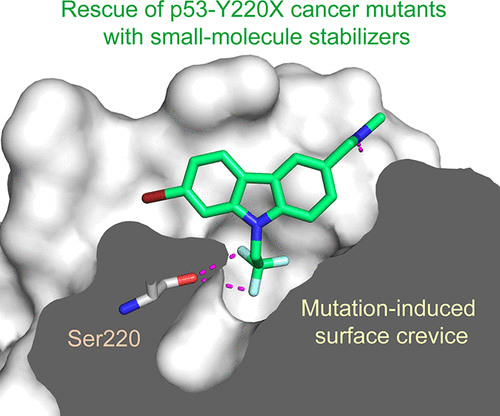当前位置:
X-MOL 学术
›
ACS Chem. Biol.
›
论文详情
Our official English website, www.x-mol.net, welcomes your
feedback! (Note: you will need to create a separate account there.)
Targeting Cavity-Creating p53 Cancer Mutations with Small-Molecule Stabilizers: the Y220X Paradigm.
ACS Chemical Biology ( IF 3.5 ) Pub Date : 2020-02-21 , DOI: 10.1021/acschembio.9b00748 Matthias R Bauer 1 , Andreas Krämer 2, 3 , Giovanni Settanni 4 , Rhiannon N Jones 5 , Xiaomin Ni 2, 3 , Raysa Khan Tareque 5 , Alan R Fersht 1 , John Spencer 5 , Andreas C Joerger 2, 3
ACS Chemical Biology ( IF 3.5 ) Pub Date : 2020-02-21 , DOI: 10.1021/acschembio.9b00748 Matthias R Bauer 1 , Andreas Krämer 2, 3 , Giovanni Settanni 4 , Rhiannon N Jones 5 , Xiaomin Ni 2, 3 , Raysa Khan Tareque 5 , Alan R Fersht 1 , John Spencer 5 , Andreas C Joerger 2, 3
Affiliation

|
We have previously shown that the thermolabile, cavity-creating p53 cancer mutant Y220C can be reactivated by small-molecule stabilizers. In our ongoing efforts to unearth druggable variants of the p53 mutome, we have now analyzed the effects of other cancer-associated mutations at codon 220 on the structure, stability, and dynamics of the p53 DNA-binding domain (DBD). We found that the oncogenic Y220H, Y220N, and Y220S mutations are also highly destabilizing, suggesting that they are largely unfolded under physiological conditions. A high-resolution crystal structure of the Y220S mutant DBD revealed a mutation-induced surface crevice similar to that of Y220C, whereas the corresponding pocket's accessibility to small molecules was blocked in the structure of the Y220H mutant. Accordingly, a series of carbazole-based small molecules, designed for stabilizing the Y220C mutant, also bound to and stabilized the folded state of the Y220S mutant, albeit with varying affinities due to structural differences in the binding pocket of the two mutants. Some of the compounds also bound to and stabilized the Y220N mutant, but not the Y220H mutant. Our data validate the Y220S and Y220N mutants as druggable targets and provide a framework for the design of Y220S or Y220N-specific compounds as well as compounds with dual Y220C/Y220S specificity for use in personalized cancer therapy.
中文翻译:

使用小分子稳定剂靶向产生空腔的 p53 癌症突变:Y220X 范式。
我们之前已经表明,小分子稳定剂可以重新激活不耐热、产生空腔的 p53 癌症突变体 Y220C。在我们不断努力发掘 p53 mutome 的可药物变体的过程中,我们现在分析了密码子 220 处其他癌症相关突变对 p53 DNA 结合域 (DBD) 的结构、稳定性和动力学的影响。我们发现致癌的 Y220H、Y220N 和 Y220S 突变也高度不稳定,这表明它们在生理条件下很大程度上未折叠。Y220S 突变体 DBD 的高分辨率晶体结构揭示了类似于 Y220C 的突变诱导表面裂缝,而相应的口袋对小分子的可及性在 Y220H 突变体的结构中被阻止。因此,一系列咔唑类小分子,设计用于稳定 Y220C 突变体,也结合并稳定了 Y220S 突变体的折叠状态,尽管由于两个突变体结合口袋的结构差异而具有不同的亲和力。一些化合物还结合并稳定了 Y220N 突变体,但不结合 Y220H 突变体。我们的数据验证了 Y220S 和 Y220N 突变体作为药物靶点,并为设计 Y220S 或 Y220N 特异性化合物以及具有双重 Y220C/Y220S 特异性的化合物提供了框架,用于个性化癌症治疗。
更新日期:2020-02-21
中文翻译:

使用小分子稳定剂靶向产生空腔的 p53 癌症突变:Y220X 范式。
我们之前已经表明,小分子稳定剂可以重新激活不耐热、产生空腔的 p53 癌症突变体 Y220C。在我们不断努力发掘 p53 mutome 的可药物变体的过程中,我们现在分析了密码子 220 处其他癌症相关突变对 p53 DNA 结合域 (DBD) 的结构、稳定性和动力学的影响。我们发现致癌的 Y220H、Y220N 和 Y220S 突变也高度不稳定,这表明它们在生理条件下很大程度上未折叠。Y220S 突变体 DBD 的高分辨率晶体结构揭示了类似于 Y220C 的突变诱导表面裂缝,而相应的口袋对小分子的可及性在 Y220H 突变体的结构中被阻止。因此,一系列咔唑类小分子,设计用于稳定 Y220C 突变体,也结合并稳定了 Y220S 突变体的折叠状态,尽管由于两个突变体结合口袋的结构差异而具有不同的亲和力。一些化合物还结合并稳定了 Y220N 突变体,但不结合 Y220H 突变体。我们的数据验证了 Y220S 和 Y220N 突变体作为药物靶点,并为设计 Y220S 或 Y220N 特异性化合物以及具有双重 Y220C/Y220S 特异性的化合物提供了框架,用于个性化癌症治疗。











































 京公网安备 11010802027423号
京公网安备 11010802027423号